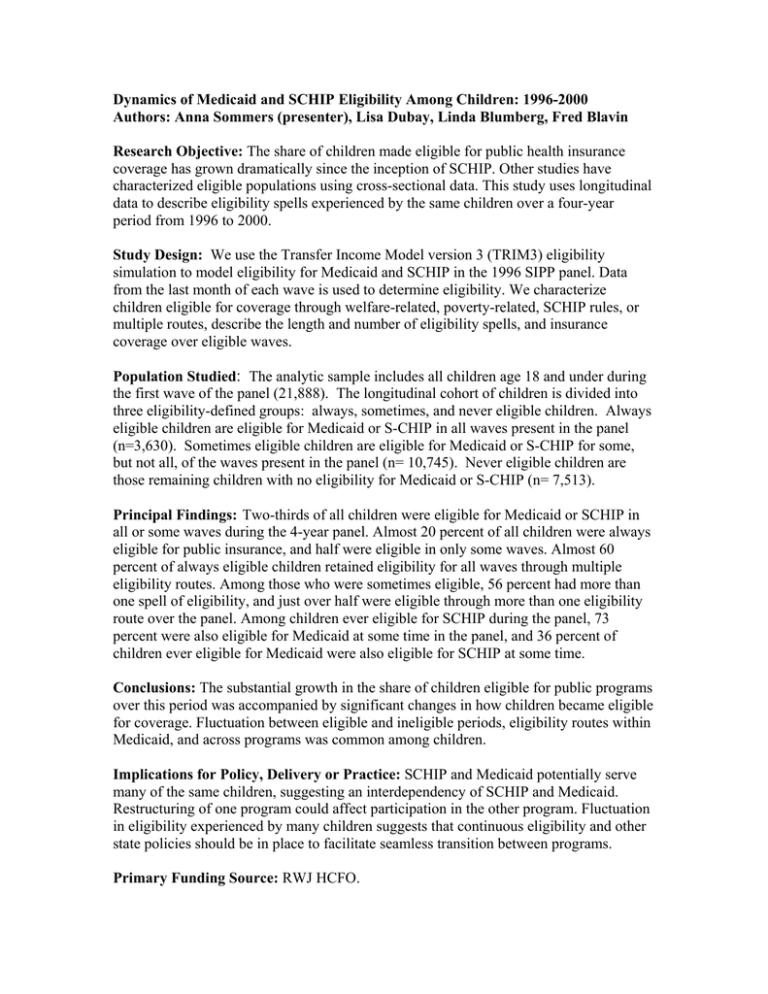Dynamics of Medicaid and SCHIP Eligibility Among Children: 1996-2000
advertisement

Dynamics of Medicaid and SCHIP Eligibility Among Children: 1996-2000 Authors: Anna Sommers (presenter), Lisa Dubay, Linda Blumberg, Fred Blavin Research Objective: The share of children made eligible for public health insurance coverage has grown dramatically since the inception of SCHIP. Other studies have characterized eligible populations using cross-sectional data. This study uses longitudinal data to describe eligibility spells experienced by the same children over a four-year period from 1996 to 2000. Study Design: We use the Transfer Income Model version 3 (TRIM3) eligibility simulation to model eligibility for Medicaid and SCHIP in the 1996 SIPP panel. Data from the last month of each wave is used to determine eligibility. We characterize children eligible for coverage through welfare-related, poverty-related, SCHIP rules, or multiple routes, describe the length and number of eligibility spells, and insurance coverage over eligible waves. Population Studied: The analytic sample includes all children age 18 and under during the first wave of the panel (21,888). The longitudinal cohort of children is divided into three eligibility-defined groups: always, sometimes, and never eligible children. Always eligible children are eligible for Medicaid or S-CHIP in all waves present in the panel (n=3,630). Sometimes eligible children are eligible for Medicaid or S-CHIP for some, but not all, of the waves present in the panel (n= 10,745). Never eligible children are those remaining children with no eligibility for Medicaid or S-CHIP (n= 7,513). Principal Findings: Two-thirds of all children were eligible for Medicaid or SCHIP in all or some waves during the 4-year panel. Almost 20 percent of all children were always eligible for public insurance, and half were eligible in only some waves. Almost 60 percent of always eligible children retained eligibility for all waves through multiple eligibility routes. Among those who were sometimes eligible, 56 percent had more than one spell of eligibility, and just over half were eligible through more than one eligibility route over the panel. Among children ever eligible for SCHIP during the panel, 73 percent were also eligible for Medicaid at some time in the panel, and 36 percent of children ever eligible for Medicaid were also eligible for SCHIP at some time. Conclusions: The substantial growth in the share of children eligible for public programs over this period was accompanied by significant changes in how children became eligible for coverage. Fluctuation between eligible and ineligible periods, eligibility routes within Medicaid, and across programs was common among children. Implications for Policy, Delivery or Practice: SCHIP and Medicaid potentially serve many of the same children, suggesting an interdependency of SCHIP and Medicaid. Restructuring of one program could affect participation in the other program. Fluctuation in eligibility experienced by many children suggests that continuous eligibility and other state policies should be in place to facilitate seamless transition between programs. Primary Funding Source: RWJ HCFO.


